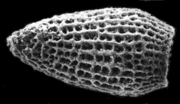 | Rhizaria Cercozoa Endomyxa Foraminifera Radiolaria Alveolata Stramenopiles... 125 KB (11,121 words) - 15:57, 22 April 2024 |
 | Rhizaria Cercozoa Endomyxa Foraminifera Radiolaria Alveolata Stramenopiles... 61 KB (6,029 words) - 18:37, 23 April 2024 |
 | a group of radiolarians. They include the vast majority of the fossil radiolaria, as their skeletons are abundant in marine sediments, making them one... 2 KB (175 words) - 15:08, 31 December 2022 |
Paleocene of Western Kuban. Radiolyarii paleotsena zapadnoi Kubani (Paleocene Radiolaria of Western Kubanj). NN Borisenko - Voprosy geologii, bureniya i ekspluatatsii... 1 KB (41 words) - 18:35, 15 April 2024 |
 | Cercozoa, they are all non-photosynthethic, but many foraminifera and radiolaria have a symbiotic relationship with unicellular algae. A multicellular... 17 KB (1,543 words) - 05:33, 22 April 2024 |
 | capturing food, sensation, movement, and attachment. They are similar to Radiolaria, but they are distinguished from them by lacking central capsules and... 6 KB (450 words) - 15:04, 12 November 2023 |
 | Rhizaria Cercozoa Endomyxa Foraminifera Radiolaria Alveolata Stramenopiles... 94 KB (8,002 words) - 22:45, 7 April 2024 |
 | Marine protists (redirect from Marine radiolaria) Boltovskoy, Demetrio; Anderson, O. Roger; Correa, Nancy M. (2017). "Radiolaria and Phaeodaria". Handbook of the Protists. Springer, Cham. pp. 731–763... 131 KB (10,542 words) - 04:29, 6 January 2024 |
formation in the Crook, Grant, and Harney Counties in Oregon. It preserves radiolaria and ichthyosaur fossils dating back to the Pliensbachian stage of the... 3 KB (139 words) - 22:57, 17 December 2021 |
delineating the nature of Radiolaria, as well as disambiguating the nature of the relationship between Fossilized Radiolaria and sedimentary deposition... 9 KB (1,061 words) - 00:46, 4 March 2024 |
 | Rhizaria Cercozoa Endomyxa Foraminifera Radiolaria Alveolata Stramenopiles... 200 KB (19,084 words) - 20:30, 1 April 2024 |
 | Rhizaria Cercozoa Endomyxa Foraminifera Radiolaria Alveolata Stramenopiles... 35 KB (2,489 words) - 19:31, 21 April 2024 |
 | Rhizaria Cercozoa Endomyxa Foraminifera Radiolaria Alveolata Stramenopiles... 82 KB (8,938 words) - 18:20, 14 April 2024 |
 | Rhizaria Cercozoa Endomyxa Foraminifera Radiolaria Alveolata Stramenopiles... 20 KB (1,891 words) - 13:04, 30 December 2023 |
 | elements (as in Acantharea, Pylocystinea, Phaeodarea - collectively the 'radiolaria', and Ebriida). Protozoa mostly reproduce asexually by binary fission... 52 KB (5,202 words) - 09:36, 19 April 2024 |
 | Siliceous ooze (section Radiolaria) formation. The Burubaital deposits have led researchers to believe that radiolaria played a significant role in the late Cambrian silica cycle. The late... 25 KB (3,100 words) - 11:42, 17 December 2023 |
 | worms and silica forms the exoskeleton of the microscopic diatoms and radiolaria. Other invertebrates may have no rigid structures but the epidermis may... 80 KB (8,860 words) - 14:31, 11 April 2024 |
 | Protists in the fossil record (section Radiolaria) evolved a planktonic lifestyle. Fossil radiolarian The earliest known radiolaria date to the very start of the Cambrian period, appearing in the same beds... 70 KB (7,729 words) - 07:09, 4 January 2024 |
 | many fungi (chytrids, oomycetes, zygomycetes, ascomycetes), and some Radiolaria (Spumellaria and Acantharia); it seems to be the most primitive type.... 71 KB (7,305 words) - 11:58, 27 April 2024 |








